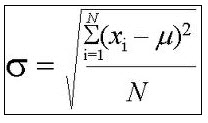MidRange Calculator
Instructions: Enter the sample data below and the solver will provide step-by-step calculation of the Mid-Range, using the form below;
MidRange Calculator
More about the MidRange Calculator so you can better understand the results provided by this calculator.
How do you calculate the midrange?
For a sample of data, the midrange, which is computed as the average of the minimum and maximum values of the sample, corresponds to a measure of central tendency that can be used sometimes.
Mathematically, we get that the midrange is computed using the following formula:
\[ \text{MidRange} = \displaystyle \frac{\min + \max}{2}\]Possible uses of the midrange
- When the sample mean is not known, you can use the midrange as a rough measure of central tendency
- It is less commonly reported as a descriptive statistic, but it can give you an idea of the midpoint of where the data is located
- Sometimes, the midrange will be very close to the mean and the median
Is midrange the same as median?
Not necessarily. For certain specific datasets they could potentially coincide, but there are different descriptive statistics. They both attempt to measure central tendency.
Descriptive Statistics Calculators
If you need a summary of all descriptive statistics, including measures of central tendency and deviation, please check our step-by-step descriptive statistics calculator :
On the other hand, if you may want a quick calculation of the mean and standard deviation, as the main summary measures, especially when the data does not have outliers nor is strongly skewed.

Example of Midrange calculation
Question: Supposed that you have the following sample dataset: 3, 1, 1, 2, 3, 4, 5, 6, 14, 13, 4, 6, 9, 10. Compute the midrange.
Solution:
These are the sample data that have been provided:
| \(X\) |
| 3 |
| 1 |
| 1 |
| 2 |
| 3 |
| 4 |
| 5 |
| 6 |
| 14 |
| 13 |
| 4 |
| 6 |
| 9 |
| 10 |
Based on the data above, the minimum value of the sample is \(\min = 1\), and the maximum value of the sample is \(\max = 14\).
Therefore, the midrange is computed, by definition, as follows:
\[ \begin{array}{ccl} \text{MidRange} & = & \displaystyle \frac{(\min + \max)}{2} \\\\ \\\\ & = & \displaystyle \frac{(1 + 14)}{2} \\\\ \\\\ & = & 7.5 \end{array}\]Therefore, based on the data provided, the midrange is \(7.5 \).

